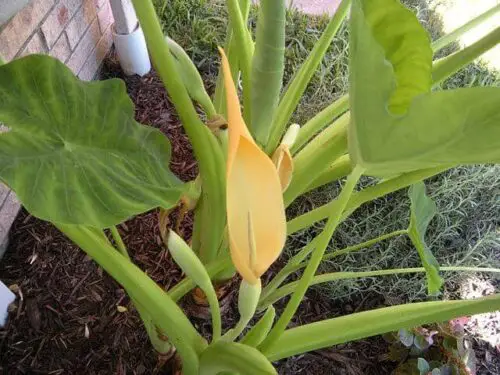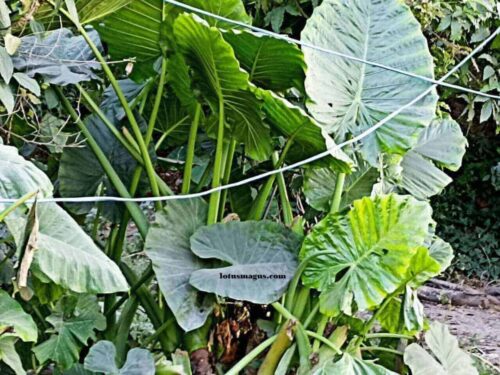To Fix Elephant Ear Plant Broken stem – Two things to resolve broken stem, either cut it and remove the stem from the base and the elephant ear plant will grow new in a few months. Secondly to resolve this you can also tie a stick or pencil on the stem using a thread or string that will need to provide it support until the repair work is done by the main plant. This will work if the stem is broken. I see tapping is the easiest option but you need to provide ground support to the stick & the tied stem will do fine tapped with the stick. If you don’t have a stick you can also use a pencil to do that.
In the serene world of gardening, there’s nothing quite as disheartening as the sight of a broken stem on your beloved elephant ear plant. These tropical beauties, with their large, dramatic leaves and striking presence, can be a source of great joy. However, like any living thing, they are vulnerable to accidents and mishaps. In this article, we’ll explore the various ways your elephant ear plant might end up with a broken stem and, more importantly, how to fix it.
How is your elephant ears plant stem broken?
Stem Split in Half
Elephant ear plants are renowned for their robust and thick stems, but sometimes, nature’s fury can be overwhelming. Wind is a common culprit. Strong gusts, especially during storms, can split the stem of your elephant ear plant right in half.
The best way to deal with a stem that’s been split in half is to act quickly. First, make sure to secure the plant in its current position. Then, you’ll want to provide some support. You can use wooden sticks or stakes to gently bind the two halves together. Be careful not to wrap them too tightly, as you don’t want to restrict the plant’s growth. Over time, as the plant heals, you can remove the support.
Partially Broken Stem
A partially broken stem can occur due to various reasons. It might be a clumsy moment while working in the garden, or perhaps a playful pet accidentally stepped on the plant. This damage is less severe than a complete split but still requires attention.
To address a partially broken stem, you can employ a simple, non-invasive technique. Gently tape the damaged parts together using plant-safe tape or floral tape. This should allow the plant to mend itself over time. Keep a close eye on the taped area and ensure it’s healing correctly.
Completely Broken Stem
A completely broken stem is a more severe situation. In this case, the stem has been separated from the main plant entirely. This can happen if someone or something exerts significant force on the stem.
To address a completely broken stem, you’ll need to cut your losses, quite literally. Prune the broken stem as cleanly as possible, making the cut just above a leaf node. This will encourage new growth. Be sure to provide the plant with adequate care in the form of water, nutrients, and the right lighting conditions to promote a speedy recovery.
Only Leaf Part Split Off
Sometimes, it’s not the stem but the leaves themselves that bear the brunt of an accident. The large, delicate leaves of elephant ear plants are prone to tearing or splitting, especially if they come into contact with sharp objects.
In this case, carefully remove the damaged leaves. Use sharp, clean scissors or pruning shears to make clean cuts. This will help your plant conserve energy and focus on new, healthy growth.
Completely Broken Stem Gets Over Newly Developed Stem
One remarkable thing about elephant ear plants is their resilience. Even if the main stem is completely broken, these plants can bounce back. The rhizomes, which are underground storage structures, can develop new stems.
If you’ve experienced a completely broken stem, be patient. Keep the plant well-watered and nourished, and in time, you may notice new shoots emerging from the rhizome. This is a testament to the plant’s will to survive.
Causes for Stem Breakage
Understanding the causes of stem breakage is essential for preventing further mishaps. Here are some common culprits:
Wind
Strong winds, particularly during storms, can cause significant damage to your elephant ear plant. The large leaves of the plant act like sails, making them vulnerable to being torn or broken.
Animal Damage
Nature’s creatures, such as deer, can find your elephant ear plant quite appealing. Their browsing can lead to broken stems and damaged leaves. If you live in an area with wildlife, consider installing protective measures, like fencing or repellents.
Neighborhood Children
Children at play can sometimes venture into your garden, leading to unintended damage to your plants. Communicating with your neighbors and setting boundaries can help prevent such incidents.
Baseball Mishaps
If your garden is located close to where neighborhood children play sports, like baseball, the occasional mishap might send a ball careening into your plants. Protect your elephant ear plants by setting up barriers or relocating them.
Fence Troubles
Fences, while essential for privacy and security, can also lead to issues. If your elephant ear plants are positioned close to a fence, they might become damaged during storms or accidents involving the fence itself.
Pets
Our beloved pets can sometimes be a source of unintended damage. Cats, dogs, or any pet with a curious disposition might trample your garden or dig around your plants. Proper training and garden placement can help mitigate these issues.

How to Fix a Broken Stem on Elephant Ear Plant
Taping
For minor stem damage, taping is a gentle and effective way to support the plant. Use plant-safe tape or floral tape to bind the damaged parts together. This will help the plant heal while maintaining its natural flexibility.
Wiring
If the damage is more extensive, you can use flexible plant or garden wire to secure the damaged stem. Make sure not to wrap it too tightly, as you don’t want to cut off circulation to the plant. Over time, as the plant heals, you can remove the wire.
Wooden Stick Support
For stems that have split but are still attached, wooden stakes or sticks can provide the necessary support. Use them to gently bind the two halves together without squeezing too tight. This method allows for the plant to recover while maintaining its natural growth.

Cutting off Completely Broken Stem
In the case of a completely severed stem, you’ll need to take decisive action. Use sharp, clean scissors or pruning shears to cut the stem cleanly, just above a leaf node. This pruning will encourage new growth and recovery.
Change Plant Location
If your elephant ear plant is situated near a fence or in an area prone to accidents, consider relocating it to a safer spot. Providing the plant with a more sheltered environment can reduce the risk of future breakage.
Protect from Mischievous Neighbors
Open communication with your neighbors can go a long way in preventing accidental damage. Ensure they understand your concerns and work together to create boundaries that keep your plants safe.
Train Your Pet
If you have pets that share your garden space, consider training them to avoid your plants. Using positive reinforcement and providing alternative areas for them to explore can help protect your precious greenery.
In conclusion, a broken stem on your elephant ear plant need not be a cause for despair. These resilient plants have the capacity to rebound with the right care and attention. Understanding the causes and employing appropriate remedies will ensure your garden continues to flourish, and your elephant ear plants stand tall and proud, undeterred by the occasional mishap.
Buy Elephant Ear plant From ETSY(recommended)
Buy Elephant Ear plant from Amazon
Read More – Elephant Ear Leaf Problems – Fix Fungal and Other leaf diseases.
Also Read:
Sago Palm – Care, Seeds, Problems, Propagation[Full Guide]
Begonias for Sale – Care, Grow, Repot, Propagate[Full Guide]
Umbrella Plant – Care , Propagation, Pruning , Types [ Full Guide]
